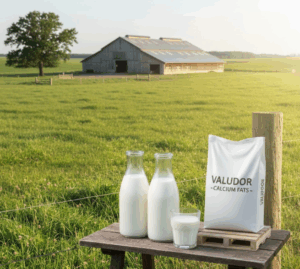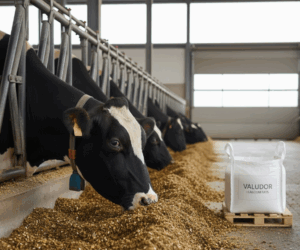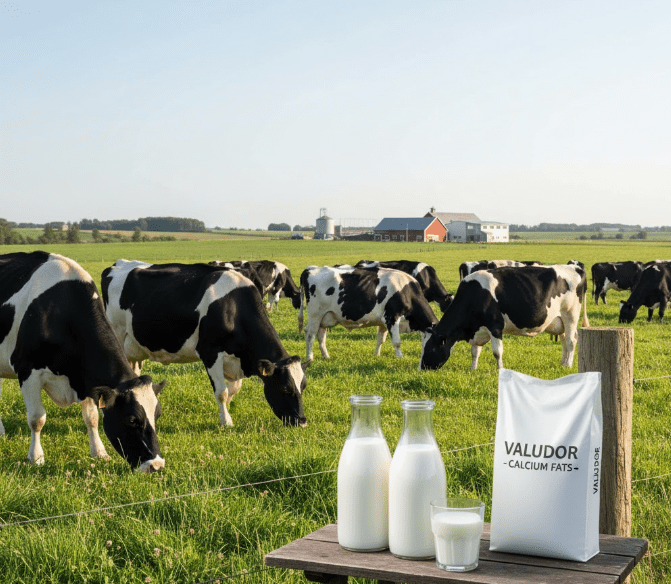Early-lactation dairy cows face one of the most intense nutritional challenges in agriculture. Energy deficits, unstable rumen pH, and the rising costs of traditional feed sources push nutritionists to find sustainable, high-ROI solutions. One tool stands out: calcium salts of fatty acids. More than just an energy supplement, these rumen-protected fats boost milk yield, enhance fat content, and support herd health—all while driving sustainable feed efficiency.
Introduction: The Energy Challenge in Modern Dairies
For mid-to-large dairy operations, particularly in North America and Europe, energy deficits in early lactation cows remain a persistent challenge. Fresh cows often enter negative energy balance (NEB), increasing their risk for metabolic disorders such as ketosis and displaced abomasum. Traditional starch-heavy diets can drive short-term milk production but compromise rumen health, leading to inconsistent performance.
Calcium salts of fatty acids (CaFA) offer a proven solution. These rumen-protected fats deliver dense energy without disrupting rumen fermentation, helping nutritionists stabilize intake, enhance milk output, and secure long-term sustainability.
What Are Calcium Salts of Fatty Acids?
Calcium salts of fatty acids are produced by reacting fatty acids—often palmitic (C16:0) or oleic (C18:1)—with calcium. This process reduces their solubility in the rumen, protecting them from microbial breakdown. As a result:
- Stable in the rumen: Less risk of disrupting microbial populations.
- Efficient in the intestine: Fatty acids are absorbed in the small intestine, providing high-energy density.
- Consistent performance: Unlike free oils, calcium salts do not depress fiber digestibility.
For dairy nutritionists, this means predictable results and fewer concerns about variable rumen pH.
The Sustainability Angle
Sustainability in dairy nutrition is more than carbon credits—it’s about doing more with less. Calcium salts contribute by:
- Improving Feed Efficiency
- Every kilogram of calcium salt supplies over 2.5 times more energy than starch.
- Cows utilize this energy more efficiently, converting feed into milk solids instead of excess body condition.
- Reducing Methane Intensity
- Studies show fat supplementation can reduce enteric methane per liter of milk, improving environmental efficiency .
- Supporting Long-Term Herd Health
- By minimizing NEB and metabolic disorders, calcium salts reduce culling rates and veterinary interventions, both costly and unsustainable practices.

Impact on Milk Yield and Components
Nutritionists demand ROI-backed solutions, and calcium salts deliver:
- Milk Yield: Consistent improvements of 2–4 kg/day have been documented .
- Milk Fat Content: Palmitic-rich blends can increase milk fat by up to 0.8%.
- Protein Balance: By reducing energy deficits, amino acids are spared for milk protein synthesis instead of gluconeogenesis.
Overcoming Early Lactation Energy Deficits
Energy is the limiting factor in fresh cow diets. Calcium salts help bridge the gap by:
- Delivering concentrated energy: 6–7 Mcal/kg of dry matter.
- Reducing mobilization of body fat: Less reliance on adipose tissue lowers the risk of ketosis.
- Improving reproductive performance: Cows in better energy balance cycle sooner and conceive earlier, shortening calving intervals .
Practical Application in Dairy Rations
For herds of 500+ cows, practical adoption matters as much as science. Key considerations:
- Inclusion Rate: Typically 3–6% of DM intake, depending on lactation stage and fat source.
- Formulation Strategy: Pair palmitic acid (C16:0) for higher milk fat with oleic acid (C18:1) for improved digestibility and body condition.
- Sourcing: Reliable suppliers such as Valudor and Megalac provide consistent blends that nutritionists can buy in bulk (1-ton pallets).
For a deeper dive into feed formulation strategies, explore our Nutrition Insights.
Regulatory and Market Considerations
With regulatory scrutiny on antibiotic alternatives, calcium salts stand out as non-medicated, safe, and compliant additives. They help farms:
- Align with sustainability reporting standards.
- Reduce dependence on volatile feed markets (corn and soybean).
- Improve profitability per liter of milk produced.
ROI and Profitability
Every additive must prove its worth. Calcium salts check this box through:
- Higher Margins: A 2–4 kg increase in milk/day at $0.40/kg adds $0.80–$1.60 per cow per day.
- Better Feed Efficiency: Less feed per liter of milk reduces cost pressure.
- Long-Term Payoff: Lower culling and improved reproduction secure multi-year benefits.
For a 500-cow herd, the ROI quickly scales into six figures annually, justifying the $50K–$200K additive spend common among progressive nutritionists.
Sustainability Case Studies
Several studies highlight the dual role of calcium salts in profitability and sustainability:
- University of Florida: Demonstrated higher milk yield and energy balance in early lactation cows supplemented with calcium salts .
- Wageningen University (Netherlands): Showed improved methane intensity reduction per liter of milk when fat was included in rations .
Addressing Common Buyer Concerns
Will calcium salts affect rumen fiber digestion?
- Research shows calcium salts do not interfere with NDF digestibility, unlike free oils .
Are they cost-effective versus other fat sources?
- Yes. The high-energy density and consistent performance make calcium salts superior to unprotected fats or alternative additives.
Are there risks in over-supplementation?
- Only when inclusion exceeds recommended 6% DM. Balanced formulations prevent issues.
Implementing a Sustainable Nutrition Program
To leverage calcium salts effectively:
- Start with herd diagnostics – identify NEB risks and milk fat trends.
- Formulate with precision – balance palmitic and oleic acid blends based on herd goals.
- Track outcomes – monitor milk yield, fat %, and feed efficiency KPIs.
- Partner with suppliers – secure bulk contracts to ensure supply consistency.

Conclusion
Calcium salts of fatty acids are more than an energy supplement—they are a strategic sustainability tool. By boosting milk yield, stabilizing rumen health, and lowering environmental impact, they enable dairy nutritionists to deliver profitable, sustainable performance in an era of rising feed costs and stricter regulations.
References (Non-Competitor, Reputable Sources)
- Knapp, J.R. et al. (2014). Invited Review: Enteric methane in dairy cattle production: Quantifying the opportunities and impact of reducing emissions. Journal of Dairy Science. https://www.journalofdairyscience.org
- Rabiee, A.R., Breinhild, K., Scott, W., Golder, H.M., Block, E., & Lean, I.J. (2012). Effect of fat additions to diets of dairy cattle on milk production and components: A meta-analysis and meta-regression. Journal of Dairy Science.
- Grummer, R.R. (1995). Impact of changes in organic nutrient metabolism on feeding the transition dairy cow. Journal of Animal Science.
- University of Florida IFAS Extension – Feeding Fat to Dairy Cows. https://edis.ifas.ufl.edu
- Wageningen University & Research – Feed and Climate Impact in Dairy Cows. https://www.wur.nl
- Palmquist, D.L., Jenkins, T.C. (2017). Fat in lactation rations. Veterinary Clinics of North America: Food Animal Practice.
Ready to boost milk yield, stabilize herd health, and drive sustainable profitability? Connect with our team today to learn how calcium salts can optimize your herd’s performance.
